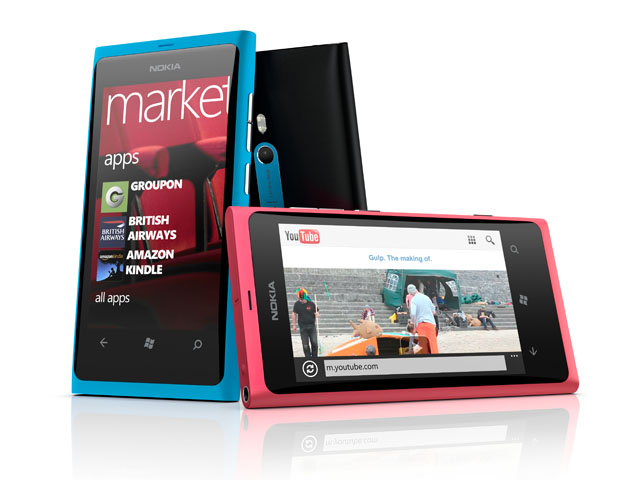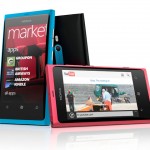review Out of all the smartphones we reviewed last year, the Nokia N9 had the design we were most impressed with. We liked the operating system, MeeGo Harmattan, as well, but given it’s essentially a dead-end platform, it’s presence on the N9 took much of the shine off the phone’s appeal.
Thankfully, the Nokia Lumia 800 doesn’t have this handicap. It has a near-identical design to the N9, but as the first fruit of Nokia’s somewhat controversial partnership with Microsoft, it runs the new Windows Phone 7.5 operating system. Does the combination of Nokia’s best-looking handset in years with Microsoft’s latest mobile computing effort equal a smartphone with the same mass market appeal of an iPhone or Android device? Read on to find out.
Design
Almost everything we loved about the Nokia N9’s design is present on the Lumia 800. The same beautifully-engineered unibody polycarbonate casing, the same unique curved glass display, and the same colour choices of black, cyan and magenta. Its dimensions are identical as well at 116.5 x 61.2 x 12.1mm, and it has the same micro-SIM slot and micro-USB port at the top that are hidden by plastic covers.
But there are a few slight differences. The screen is a slightly smaller 3.7”, with the .2” of extra screen space from the N9 used for Windows Phone’s standard three capacitive touch buttons (back, start/home and search). It’s missing the front-facing camera of the N9, but adds a dedicated camera launcher button on the right-hand side. The Lumia 800 is also 7g heavier at 142g, and the dual LED flash on the back is above rather than beside the camera.
Features
As with the hardware design, many of the N9’s features have been carried over to the Lumia 800, namely the non-expandable 16GB of storage, non-removable 1450mAh battery, 8-megapixel camera, and the use ClearBlack and AMOLED display technologies on the screen. Theoretically, it’s a little faster than the N9 as the processor has been boosted from a single-core 1GHz ARM Cortex A8 to a single-core 1.4GHz MSM8255 Snapdragon processor, but the display resolution has been down-graded to 800 x 480 as per the standard Windows Phone spec, and it doesn’t have an NFC chip like the N9.
The Lumia 800 is the first smartphone we’ve seen that runs Windows Phone 7.5 out of the box, and the two work so well together that you’d think one had been specifically designed for the other. The curved display works just as well for Windows Phone’s Metro UI has it did for MeeGo, as there’s a lot of sideways swiping to navigate between different screens in each app. The predominantly black user interface (the default theme option) also works a treat with the Lumia 800’s screen, as the combination of the ClearBlack and AMOLED display technologies result in exceptionally deep black levels that are almost indistinguishable from the surrounding screen bezel.
We won’t go into Windows Phone 7.5 in detail, but there are over 500 new features over the original version of the operating system, ranging from major additions like multi-tasking, Internet Explorer 9 and extensive integration of Facebook, Twitter and LinkedIn social networking to minor improvements like enhanced live tiles, deeper SkyDrive integration (Microsoft’s cloud service that offers 25GB of free storage), a unified inbox and support for multiple Exchange accounts. This is all on top of the existing set of features that were pretty impressive to begin with, such as the Xbox Live hub for gaming, Office hub for productivity, and People hub for managing communications, not to mention the beautifully-designed user interface.
Nokia has loaded some custom apps on the Lumia 800 as well. There’s the Nokia Drive application for turn-by-turn navigation (with local maps that you can store locally – the Australian map is a 200MB download), Nokia Maps (an app for finding local points of interest), and Nokia Music (the online music store). There’s a bit of overlap here though, as Windows Phone also includes Bing Maps and Zune Music, but the turn-by-turn app is definitely a welcome addition. It’s also worth pointing out that while Internet tethering is supported by Windows Phone 7.5, it hasn’t been implemented on the Lumia 800.
Performance
The Lumia 800 only comes with 512MB of RAM, but it turns out that’s all it really needs. Everything is delightfully fluid and snappy, from scrolling through the start screen and apps list and zooming in and out of web pages to flicking through recently-launched app cards in the multi-tasking view and browsing through content in Windows Marketplace. The only lag we came across was when launching certain third party apps, but we’re told this is a case of individual apps not taking advantage of the new multi-tasking APIs rather than a fault of the phone or the OS.
As you’d expect for a phone running Internet Explorer 9 (albeit a mobile version), the browser offers all the bells and whistles, with full support for HTML5, hardware-accelerated graphics rendering and enhanced Javascript and AJAX support. But it’s still not a patch on the Safari and Chrome browsers in iOS and Android when it comes to speed. The Lumia 800 fully loaded the desktop version of the Sydney Morning Herald website in 24 seconds, versus 12 seconds on the Samsung Galaxy Nexus and 10 seconds on the iPhone 4S, and its Rightware Browsermark score was one of the lowest we’ve seen recently at 31,081 (the Samsung Galaxy Nexus and iPhone 4S got 96,015 and 87,424 respectively).
The Lumia 800’s external speaker is a little on the quiet side, and this means you may struggle to hear calls on speakerphone in noisy environments. Music playback could also be louder, although we had no problems heading the phone ringing while we were out and about. The earpiece produces louder audio than the speakerphone, but it doesn’t really stand out with regard to volume or clarity. Battery life is good rather than great; we were able to get just over 24 hours out of it with extremely light use (roughly an hour’s worth of web browsing and email and half an hour worth of phone calls), and power users may struggle to stretch its run-time to a full workday.
Conclusion
There’s no doubt about it, the Lumia 800 is a gorgeous phone. The simplicity, elegance and fully-stocked feature set of Windows Phone 7.5 paired with the stunning hardware design of the Lumia 800 amounts to a lethal combination that will change the game for both Nokia and Microsoft. For Nokia, it’s the first smartphone that really innovates on all levels since the N95, and for Microsoft, it puts a much sexier face on its Windows Phone operating system, which is key for winning over more users. The distinctive design and eye-catching colour options will go a long way towards attracting everyday users, while the huge improvements in Windows Phone 7.5 should prove appealing for geeks and power users that are keen for something different.
The Lumia 800 isn’t officially available in Australia yet, but the fact that it’s listed on the Nokia Australia website suggests that its launch is imminent. In the mean time, it’s readily available from grey importers like Mobicity and Expansys.
Jenneth Orantia turned her back on a lucrative career in law to pursue her unhealthy obsession with consumer technology. She’s known for having at least half a dozen of the latest gadgets on her person at a time, and once won a bottle of Dom Perignon for typing 78WPM on a Pocket PC with a stylus.
Image credit: Nokia









I almost feel sorry for Nokia. Sounds like a great phone, but it is about 2 or 3 years late to save them.
And Microsoft? Boy did they waste their opportunity. I remember using a couple winmo phones back before the iPhone had proper exchange support…the iPhone wasn’t enterprise ready then (and arguably still isn’t) but… they had *some* phones worth buying …sort of…
Quite pricey outright @ $600 from mobicity for what supposedly an entry level phone.
Nice looking piece of hardware.
This has come down in price loads on Amazon – http://amzn.to/uWEEfP
Comments are closed.